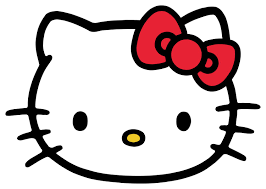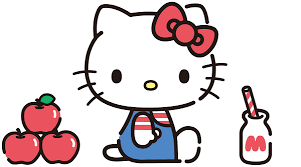Before I heard anything about Hello Kitty, I remember seeing it everywhere.
The early 2000s is when I’d say I first started noticing the iconic Japanese creation. Hello Kitty purses, t-shirts, backpacks, and keychains were dawned on so many teenage girls that it made it impossible not to be curious about what became a cultural phenomenon.
A few years later, I thought the craze died down. But like the nine lives inferred in the Hello Kitty name, the brand continued to bounce back. And while Hello Kitty celebrates its 50th anniversary this November, it remains the most popular representation of kawaii (cute) culture that we’ve experienced.
Writers, we need to learn from this longevity.
Hello Kitty can teach us valuable lessons that can be applied to how we approach cultivating a readership and fan base. To get a clearer picture of what those lessons are, we need to go back to the start.
When Hello Kitty was created by the Japanese company Sanrio back in 1974 (Yuko Shimizu was the original designer), it didn’t exactly take the global market by storm. Instead, it mostly resonated with Japanese school girls who made it part of their cultural identity.
When Sanrio realized it had captured an audience, it quickly increased its product offerings to match the excitement. The brand had found its original evangelists and it wasn’t about to miss the opportunity to capitalize on the authentic connection.
When I think about being a writer today, I can’t think of a variable more important to your success than capturing a dedicated readership. And to capture that readership, an audience needs to feel like they are connected to something larger than themselves.
Sanrio did just that. When it expanded to America within two years of its inception, the young Japanese-American diaspora made it popular.
These schoolgirls didn’t know about Sanrio’s global ambitions. All they cared about was that Hello Kitty was created in Japan and its cuteness resonated. That pride was enough to elevate the brand to its early international success.
When I think about a connective vision, I think about the inception of this newsletter. When I originally created this newsletter, I thought about naming it Kern Carter. My first name is original enough. I had a small but mighty community that I had built the years before I started using Substack so I did feel like my name meant something.
But I wanted this newsletter to feel bigger than me. I wanted to be connected to a vision and a mission that could inspire writers just by its name alone. That’s why I named it Writers Are Superstars. This is a calling for writers to be confident in who they are and to recognize their value to culture. And with close to 3,000 subscribers, I would say that vision is being accepted by a growing community.
Hello Kitty did something similar. A lot of people may not know this but Hello Kitty is not the name of the character. The name of the actual Hello Kitty character is Kitty White, and the backstory her creators gave her was that she grew up in London.
The phrase Hello Kitty was created to represent the fullness of the brand. I don’t think it’s a stretch to say that if Sanrio decided to present the brand as Kitty White instead of Hello Kitty, people wouldn’t have connected to it in the same way. Even the minimal facial features makes it so consumers can better ascribe their own personality onto the brand. These are deliberate tactics designed to heighten the feeling of ownership someone feels when they see a Hello Kitty product.
That’s one important lesson. Another lesson is one that comes up again and again through my research of popular culture.
I started this piece by saying that I saw Hello Kitty everywhere before I heard about it. That’s because Sanrio was not shy about licensing the Hello Kitty brand, so long as it stayed connected to the kawaii culture that Hello Kitty helped define.
When licensing the name, Hello Kitty was essentially creating partnerships. One of its most recent and successful partnerships was Hello Kitty Island Adventure. It’s a video game created by game developer Sunblink using the Hello Kitty brand.
In July of 2023, Sunblink took Hello Kitty and turned it into an award-winning adventure game that introduced the brand to an entirely new audience.
For its 50th anniversary in 2024, Hello Kitty forged collaborations with Casio, Crocs, Converse, Adidas Forum, Balenciaga and more. After half a century in the game, this level of partnership proves Hello Kitty has figured out a formula to remain relevant.
I’ve said this many times before, but partnerships are one of the areas writers struggle with the most. In fact, most writers’ best example of a partnership is guest blogging. But when I think of partnerships, I’m thinking about the infinite possibilities outside the writing and publishing industry. I’m thinking about hopping on trends and understanding popular cultural shifts.
Writers leave too much on the table when it comes to collaborations. From the potential for collaborations with other artists (visual, photographers, fashion designers), to corporate opportunities, to social justice connections, the possibilities are endless and largely untapped.
Part of Hello Kitty’s formula for longevity is in its ubiquity. They’ve used partnerships through licensing to spread the brand across the world. As an emerging writer, you don’t need to scale as broadly, but you should be open and searching for those collaborative opportunities outside the literary industry.
If you’re willing to do that, while also creating a mission that is bigger than yourself, then you give yourself a chance at building a readership wide enough to supercharge your writing career.
With that being said, the final lesson writers need to consider is this: protect your brand.
As much as Hello Kitty has licensed its name, it’s not casual about defending its brand. In 2014, Sanrio sponsored a Hello Kitty exhibition in Los Angeles. The curator of the show made the mistake of referring to Hello Kitty as a cat.
That did not go well.
Sanrio jumped in and contacted Christine R. Yano, the curator of the exhibition, and told her that, “Hello Kitty is not a cat. She’s a cartoon character. She is a little girl. She is a friend. But she is not a cat. She’s never depicted on all fours. She walks and sits like a two-legged creature. She does have a pet cat of her own, however, and it’s called Charmmy Kitty.”
As a writer trying to reach an audience and form partnerships, it wouldn’t make sense to dilute your voice in the process. The brand you’re building has a perspective, and there should always be non-negotiables when sharing that perspective.
Is all of this making sense? Do you see how even something like Hello Kitty, which is seemingly far outside of the literary world, can still teach writers valuable lessons?
Pop culture is happening every day, and when we break it down on Writers Are Superstars, we learn all the ways we writers can become better at infusing ourselves into that culture. And once we’re there, we leverage the pieces we need to propel us to new heights.
That’s why you’re here.








I never understood "Hello Kitty's" appeal to young girls before. Thanks for the information.
And again I totally agree with you! What a surprise… collaboration and support is the healthy way forward, not competition. You always make me think in new ways. Thank you Kern!